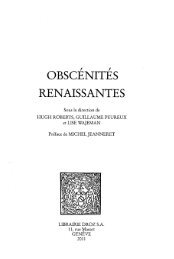Download (3398Kb) - ePrints Soton - University of Southampton
Download (3398Kb) - ePrints Soton - University of Southampton
Download (3398Kb) - ePrints Soton - University of Southampton
You also want an ePaper? Increase the reach of your titles
YUMPU automatically turns print PDFs into web optimized ePapers that Google loves.
showed that species with internal fertilization and presumably high rates <strong>of</strong><br />
fertilization display similar patterns <strong>of</strong> egg variation to those species with freely<br />
spawned gametes, thus they suggest that factors other than gamete encounter might be<br />
determinant for egg size evolution across different modes <strong>of</strong> reproduction.<br />
McEdward and Morgan (2001) analyzed the relationship between size <strong>of</strong> eggs<br />
and the energy contained in them using published data for 47 species <strong>of</strong> echinoderms<br />
(Table 4.1). They found that among echinoderms, larger eggs contain more energy,<br />
suggesting a general pattern in which energy scales very nearly in direct proportion to<br />
the volume <strong>of</strong> the egg across a significant range <strong>of</strong> egg sizes, both within and among<br />
different modes <strong>of</strong> development. The only exception is among species with<br />
planktotrophic larval development, where there does not appear to be a clear scaling<br />
relationship. However, there were wide confidence intervals around the estimated<br />
regression parameters in all <strong>of</strong> the analyses performed by McEdward and Morgan<br />
(2001). In addition, in all cases the predictive power <strong>of</strong> the regression was poor,<br />
requiring large differences in egg size in order to produce significantly different<br />
predictions <strong>of</strong> energy content. Therefore they concluded that egg size is <strong>of</strong> limited<br />
value for the quantitative prediction <strong>of</strong> egg energy content and should be used with<br />
caution in life-history studies.<br />
Natural selection is considered to drive the level <strong>of</strong> egg provisioning towards<br />
reproductive strategies with high fitness. If a single maximum is observed in the<br />
fitness curve, then selection will be expected to direct towards that best adaptation.<br />
However, if the fitness curve possesses another shape, for example curved upward<br />
(concave), then an adaptive valley between two optima might exist, and selection will<br />
be expected to be disruptive across that region.<br />
75
















